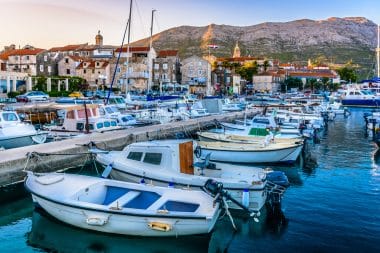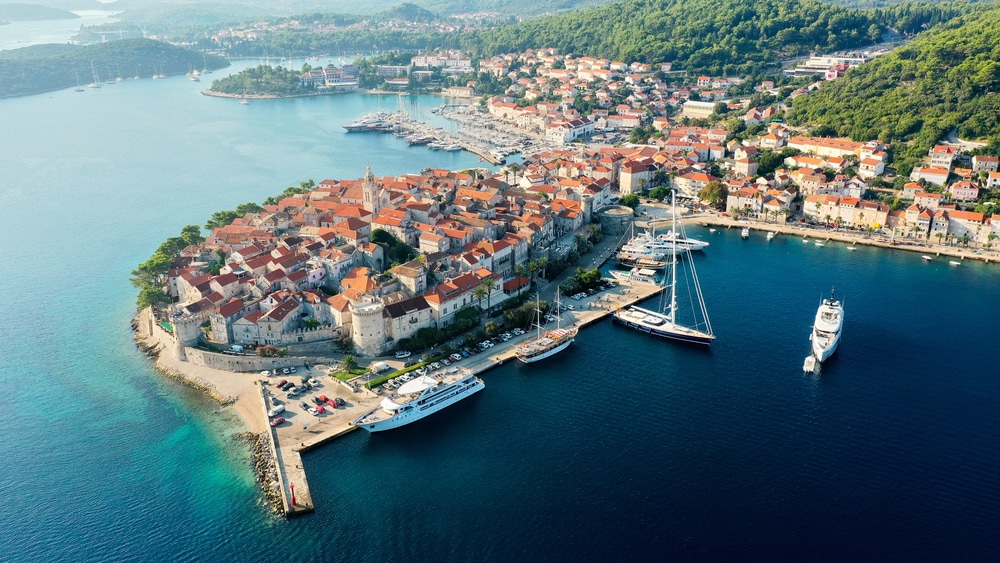The current 16,000 inhabitants are proud of their green and scenic home of Korčula anyway. Korčula is thus the most populous island in the Croatian Adriatic after Krk. But the fact that the family of the famous explorer and world traveler Marco Polo may have come from there and that he may have been born there in the middle of the 13th century still makes the hearts of the islanders beat faster today. It is disputed among historians whether the alleged birthplace in the 5,500-inhabitant town of Korčula in the east of the island actually housed the cradle of the seafarer and trader.
However, since Korčula was one of the possessions of the Republic of Venice at that time, it cannot be completely ruled out. In addition to the Romanesque-Gothic St. Mark’s Cathedral, built from the 14th to the 19th century, the massive and well-preserved city fortifications and the former Venetian governor’s palace, the building is one of the most famous and most visited sights in the city.
The best way to explore the densely overgrown and wooded island is on foot
The dense and dark forests, mainly of pines and cypresses, which gave the almost 280 km² island the ancient Greek name “Black Corfu” (Melaina Korkyra) in antiquity, have been cut down on a large scale since the Middle Ages for house and ship building, but still shape the appearance, especially in the west. In general, the island with its lush vegetation is a real hiker’s paradise. Especially in the still mild spring, the numerous well-developed and picturesque routes through fields, pastures, meadows and vineyards are ideal for extended tours. Among the most beautiful hiking destinations are the hills of Veliki Hom and Sveti Stas near Zrnovo, the routes from Korcula town via Dracevica to Gornje Blato and Lumbarda as well as those to the mountain Sveti Ilija on the opposite peninsula of Peljesac around the villages of Viganj, Zukovac, Bilopolje and Orebic. As part of the excursion, you can also visit a Franciscan monastery from 1470 and a maritime museum with many historical paintings and other relics.
The sea and the numerous beaches are always just a stone’s throw away

Korčula has many romantic swimming spots and beaches with crystal clear waters in hidden and secluded small bays along its coast, which are fantastic for a long day at the sea with family and friends. The mostly rocky, stony and sandy beaches extend mainly over the eastern part of the island. The most popular sections in midsummer include the sandy beach Vela Przina in Lumbarda and the pebble beach Pupnatska Luka near Korčula Town. Other well-visited beaches with offers for water sports and gastronomy in and around the main town of the island are the beach Banje east of the centre, the beach Luka Korculanska, the bathing area Mandrac at the Maksimilijan Vanka museum, the small beach Ispod Duvana with a view of the old town, the beach Puntin not far from the harbour, the beach Spomenik near Plokata and the beach in Sveti Nikola with ladders for access to the sea. Around the small town of Lumbarda, which is also known nationwide for its local white wine “Grk”, southeast of Korčula town, are the sandy or rocky beaches of Vela Przina, Bilin Zal, Tatinja, Lenga and Raznjic, which are equally worth a trip.
Water sports and active sports holidays are possible almost everywhere on Korčula
Due to its ideal geographical location on the Peljesac Strait near Viganj, with the Mistral wind that blows reliably there almost all year round, surfing is an extremely popular sport in the waters off Korčula. This is why the World Championships took place here in 1989 and the European Windsurfing Championships in 1990. The Windsurfing Department of the Faculty of Sport and Physical Education of the University of Zagreb has been training regularly on the island since 1981.
The above-mentioned Mistral also makes the island a famous sailor’s paradise: boat and boat rentals as well as sailing schools are available, for example, at the “Oreb Club Sailing & Windsurfing School Center” in Korčula Town and in Lumbarda. The locals have been making a living from fishing for thousands of years, so it is not surprising that hobby and deep-sea anglers also get their money’s worth here on holiday. The local fishing club KANJAC organizes a big fishing competition every year on July 27th, in which guests and visitors can also participate and win great prizes. Fishing equipment such as bait, floats, hooks, rods and traps are available at a fishing shop right in the centre of Korčula Town, where trips with local fishermen to the surrounding waters are also arranged.
Explore even the most remote corners of the island by rental car or bike
In addition to the most touristy resorts of Korčula Town, Lumbarda and Vela Luka, where most of the accommodation of all categories and classes are located, there are many other smaller towns on the island that are worth seeing and are ideal for excursions by car or bike. The small and cozy village of Zrnovo is known for its ancient cypresses, terraced vineyards and olive groves, as well as stone houses, bell towers and churches. The bays of Orlandusa, Pavja Luka and Rasohatica are within easy walking distance. The fishing village of Racisce in one of the northern bays has only about 500 inhabitants, in the two bays Vaja and Samograd there are prehistoric caves. Pupnat is the oldest settlement on the island with well-preserved architecture, and Pupnatska Luka Bay is home to one of the most beautiful pebble beaches on the island. In the villages of Cara and Smokvica the famous white wines “Posip” and “Rukatac” are produced, good bathing opportunities are offered by the local bays Zavalatica and Zitna.


